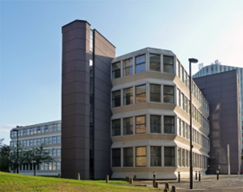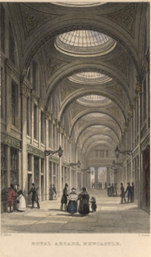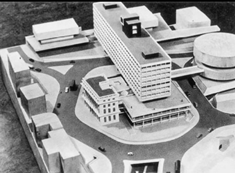Newcastle’s ‘failed’ Modernist Architecture
According to Martinelli, F., Moulaert, F. and Novy, A. Urban and Regional Development Trajectories in Contemporary Capitalism. (2013) With the rise of state capitalism and Keynesian economics after World War II. Northern industry began to decline due to postwar deindustrialization. However Newcastle’s architecture did not decline along with its former factories. Instead, it began to develop as a result of national economic planning under Keynesian economics. In the process, some blocks of the city were removed, and new infrastructure such as a highway network was built that changed the city’s original shape. New streets were carved out and many new modernist buildings were built in Newcastle, but not all of them were popular with the public.

Bede House, City Road, Newcastle https://www.geograph.org.uk/photo/4637302
Bede House is a modernist building in the center of Newcastle, next to All Saints Church. Built-in 1969 as one of the buildings of The All Saints scheme as part of an originally ambitious and idealistic urban plan. This vision itself is only partially realized.


Tyne And Wear, Newcastle Upon Tyne, All Saints Development https://canmore.org.uk/site/289146/tyne-and-wear-newcastle-upon-tyne-all-saints-development
No reason has been found for the decline of this street.
Although the building is perfectly situated between the riverside landscape to the south and the commercial district to the north, the land has become abandoned. Companies keep trying to take over but keep failing. The last time it came into public view was in 2017, it was bought by Maya Capital LLP for 4 million pounds and was ready to be invested into a city center office building. However, as of May 2024, this change has not yet been realized.

Swan House https://www.somethingconcreteandmodern.co.uk/building/swan-house/
Swan House is so unique, Morton, D. (2016) said, Swan House is to some people the face of Newcastle, but to others, it is an eyesore.
Surrounded by highways and roundabouts, Swan House looks like an island floating on a transportation hub. What has led to the current situation, however, is an unfinished urban design idea from the last century: a city where pedestrian transportation relies entirely on a system of skywalks.
A model of the intended Swan House with a rebuilt Royal Arcade next to it. The Arcade was never rebuilt https://www.chroniclelive.co.uk/incoming/gallery/swan-house-roundabout-12056321
This building failed to accompany the idealistic urban planning led by T. Dan Smith in the last century and was not completed along with his supporting facilities: there are no convenient pedestrian facilities making it difficult for pedestrians to approach the building. After that, the privatization process of the Thatcher government cut off the possibility of realizing this ideal by manchesterhistory.net. (n.d.).

Aerial view of the construction of the Central Motorway and Swan House roundabout, estimated to be in 1971.
https://medium.com/@peterkwells/the-bumpy-road-to-economic-and-social-value-396f1a7a43d2

Royal Arcade, Newcastle (demolished 1963)
https://co-curate.ncl.ac.uk/royal-arcade/
Newcastle’s Royal Arcade was demolished to build the building. Morton, D. (2021). The arcade was demolished brick by brick in 1963-64 with the intention of rebuilding next to Swan House. It has been on planning models ever since. But it was never rebuilt. But its disappearance has allowed retail sales near the Newcastle Monument to grow, and the construction of Eldon Sq mall has concentrated consumption in the west rather than the east of the city. For various reasons, this arcade never came back…
summary
This article explores the impact of these modernist buildings on the city and public impression from an in-depth perspective. The success or failure of modernist architecture will take more time to know but as Martinelli, F., Moulaert, F. and Novy, A. (2013). Urban and Regional Development Trajectories in Contemporary Capitalism. As mentioned, the life cycle of buildings under a capitalist economy may end prematurely for some commercial reasons. We may see a day of revival of these buildings over time, and it is more likely to see them demolished before that day comes.
Reference list
www.geograph.org.uk. (2012). Geograph: Bede House, City Road, Newcastle © Stephen Richards cc-by-sa/2.0. [online] Available at: https://www.geograph.org.uk/photo/4637302 [Accessed 12 May 2024].
manchesterhistory.net. (n.d.). 55 Degrees North, Formerly Swan House, Newcastle-upon-Tyne, UK. [online] Available at: https://manchesterhistory.net/architecture/1970/swanhouse.html [Accessed 12 May 2024].
Martinelli, F., Moulaert, F. and Novy, A. (2013). Urban and Regional Development Trajectories in Contemporary Capitalism. DOI: https://doi.org/10.4324/9780203075326.
Morton, D. (2016). Newcastle’s Swan House: Landmark or eyesore? [online] ChronicleLive. Available at: https://www.chroniclelive.co.uk/news/history/newcastles-swan-house-area-city-12055997.
Morton, D. (2021). The vanished Newcastle arcade which Grainger and Dobson got horribly wrong. [online] Chronicle Live. Available at: https://www.chroniclelive.co.uk/news/history/newcastle-royal-arcade-dobson-grainger-19571209 [Accessed 12 May 2024].



